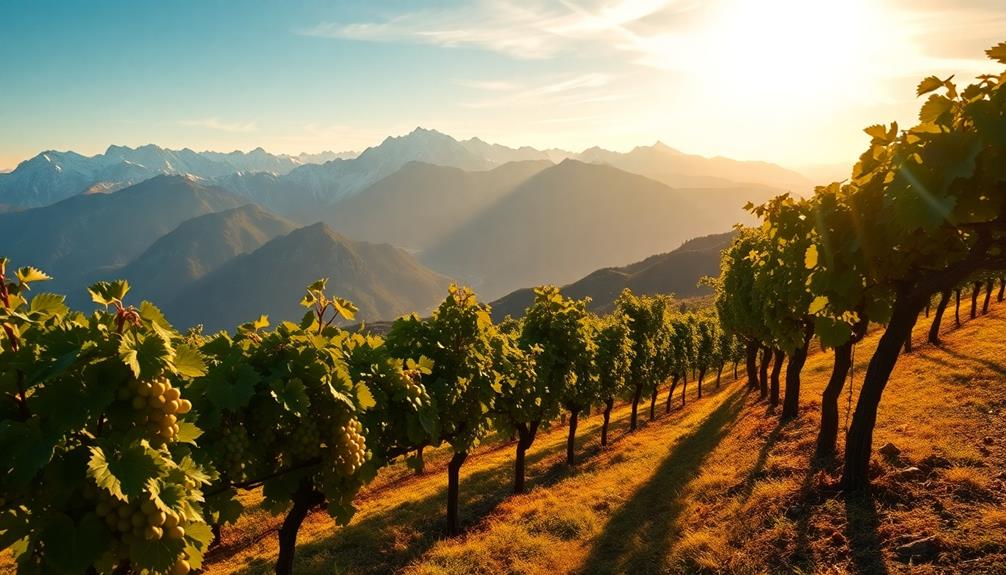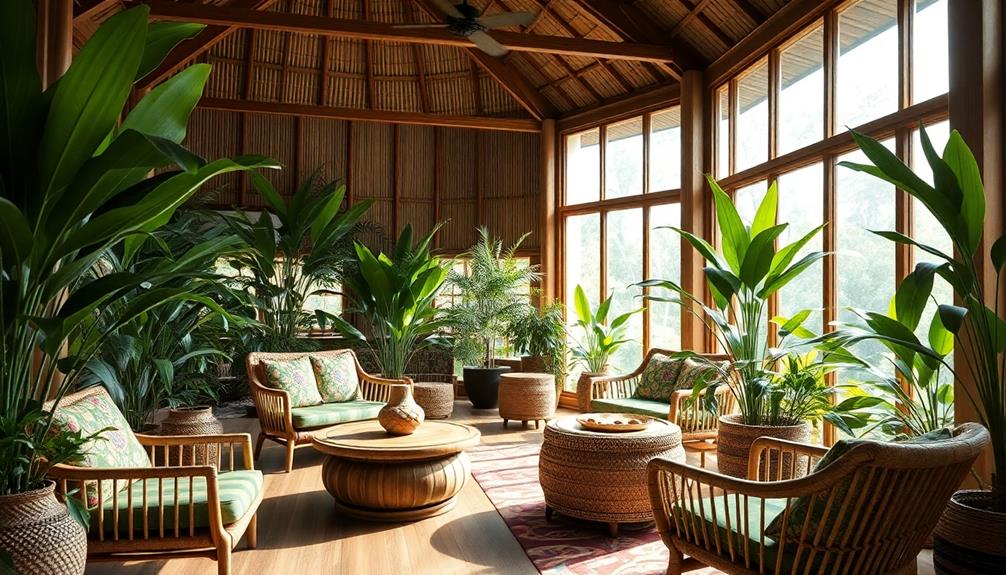Altitude really changes how you taste wine. At elevations above 6,000 feet, lower air pressure dulls your palate and nose, making flavors less vibrant. Dehydration can heighten that effect, leaving you feeling tipsier than usual. However, grapes grown at high altitudes benefit from cooler temperatures and intense sunlight, leading to richer flavors and concentrated aromas. As you sip fruity wines with lower tannins, remember that proper hydration enhances your experience. Curious about how these factors shape specific wines or what to choose for your next tasting? Keep exploring to uncover more intriguing details on wine at altitude.
Key Takeaways
- High altitudes dull taste perception due to lower air pressure, making flavors less vibrant and aromas harder to detect.
- Dehydration at high elevations decreases saliva production, heightening the astringency of tannic wines and affecting overall taste experience.
- Wines aged at high altitudes develop richer flavors and concentrated aromas due to cooler temperatures and unique environmental conditions.
- Fruity wines with low tannins and acidity are recommended for consumption at altitude to enhance enjoyment and mitigate harsh sensations.
- Aroma dissipation challenges at high altitudes complicate wine appreciation, requiring careful attention to hydration and tasting conditions.
Effects of Altitude on Taste
When you're enjoying a glass of wine at high altitudes, you might notice that the flavors aren't as vibrant as they're at sea level. This is primarily due to the lower air pressure, which can dull your palate and nose. The decreased oxygen levels at high elevations affect how you perceive wine tastes, making them seem less satisfying.
Many people report that, at elevations of 6,000-10,000 feet, the delightful complexity of their favorite wines is lost. Additionally, just like the diverse flavors found in Brazilian cuisine, the subtleties in wine can be overshadowed by altitude effects.
Dehydration is another factor at altitude. As you ascend, your body tends to lose moisture, which reduces saliva production. This can make tannic wines taste sharper and more astringent, adding to the overall disappointment of wine tasting.
The physiological effects of altitude also complicate matters; you might feel more intoxicated than usual, further altering your taste perception.
In airplane cabins, the air pressure is even lower, which exacerbates the dissipation of wine aromas. As a result, the overall flavor experience can be notably diminished.
Aging Wine at High Elevation
High altitudes not only affect how you perceive wine while tasting but can also influence the aging process of wines stored in such environments. When you're aging wine at high elevations, the lower atmospheric pressure results in reduced relative oxygen levels. This means that high altitude wines have the unique advantage of evolving more slowly compared to those at lower elevations.
You might find that the flavors develop more intricately over time, creating a richer tasting experience. Curiously, similar to how Dorayaki (Red Bean Pancake) evolves in flavor over time, the complexity of high altitude wines can enhance their character as they age.
Additionally, the cooler temperatures at high altitudes help preserve your wines, preventing them from deteriorating as quickly. This environment fosters improved air circulation, which is essential for ideal aging wine conditions.
As a result, you can expect more intense colors and concentrated aromas from your wines as they mature.
In essence, aging wine in high-altitude conditions can enhance its potential, leading to a more complex and enjoyable drinking experience. So, if you're considering where to store your prized bottles, high elevations might just be the perfect choice for achieving that optimal flavor profile.
Importance of Hydration
Hydration is crucial for fully appreciating wine, especially in elevated environments where the air is drier and oxygen levels are lower. At high altitudes, your body's need for hydration increases considerably. The dry conditions can lead to dehydration, which dulls your palate and nose, making it harder to perceive the intricate flavors and aromas of the wine.
Enjoying a dish like Nettle and Potato Soup can also aid in hydration due to its high water content, enhancing your overall tasting experience. If you're sipping on a tannic wine, you'll notice that a decreased salivary response can heighten astringency, making hydration even more essential for an enjoyable tasting experience.
Moreover, it's important to remember that wine itself can contribute to dehydration. This means that while you indulge in a glass, you should also be sipping water to maintain your hydration levels. Without proper hydration, the overall tasting experience can become less satisfying, as the nuances of the wine may escape your notice.
Selecting Wine for Travel
Exploring wine while traveling can be a delightful experience, but altitude and air pressure can considerably impact your selection. When flying or visiting high altitudes, it's wise to choose fruity wines that are low in tannins and acidity. These wines generally fare better in low oxygen environments, which can alter a wine's aroma and flavor profile.
Curiously, just as Red-Braised Pork Belly pairs well with lighter wines, certain dishes can enhance the overall tasting experience.
In airplane cabins, the reduced air pressure often heightens sensations of acidity and tannin, making some wines taste sharper than intended. By selecting lighter, fruit-forward options, you can enhance your enjoyment during your journey.
Also, remember that hydration is key when consuming wine at high altitudes or in-flight. Wine can contribute to dehydration, which affects taste perception and overall experience.
If you can, consider sampling wines from high-altitude regions at lower elevations. This allows you to appreciate their unique qualities without the adverse effects of altitude on taste.
Influence on Grape Characteristics
When it comes to wine, the altitude of the vineyard plays an essential role in shaping grape characteristics. At higher altitudes, typically above 1,200 feet, you'll notice greater temperature fluctuations that enhance grape complexity. This balance between sugar and acidity levels is vital for the wines produced. The cooler climate slows down grape ripening, allowing flavors to develop gradually and preserving natural acidity.
Additionally, the unique growing conditions similar to those found in regions producing Txakoli (White Wine) contribute to the overall flavor profile of high-altitude wines.
In these high-altitude conditions, increased solar radiation contributes to thicker grape skins. This results in deeper pigmentation, giving the grapes grown at these elevations a more intense color. As a bonus, the unique soil drainage promotes deep root growth, forcing vines to draw nutrients from less fertile soils. This not only enhances grape resilience but also adds character to the fruit.
Moreover, the varietal characteristics of the grapes are expressed more prominently in high-altitude wines. You'll find that the distinct aromas and flavors stand out due to the unique growing conditions.
Challenges of High Altitude Viticulture
High-altitude viticulture presents unique challenges that can greatly impact vine growth and grape quality. At high elevations, decreased oxygen levels hinder vine development, making it essential for you to understand how to adapt your methods.
The rocky soils in these vineyards provide excellent drainage, pushing vines to develop deep root systems to access crucial nutrients and water. Additionally, the cool climate at high altitudes can remind one of the invigorating qualities of traditional Indonesian desserts like Kue Putu, which often celebrate the use of natural ingredients.
However, this often results in lower yields, as vines produce fewer grapes. The silver lining is that those grapes tend to be of higher quality, boasting concentrated flavor compounds that can enhance your wines.
Temperature swings at high altitudes create a distinct growing season, leading to later blooms and earlier harvests. This phenomenon can elevate grape complexity, but it requires you to be vigilant and responsive to the changing conditions.
As a winemaker, you'll need to innovate and develop techniques that address these environmental challenges, ultimately producing robust and characterful wines. Understanding the intricacies of high-altitude viticulture not only helps you cope with these hurdles but also allows you to capitalize on the unique qualities that high-altitude vineyards can offer.
Notable High Altitude Wines
Wines produced at high altitudes often stand out for their distinct flavors and characteristics.
Take Versante Nord from Italy, for instance. This biodynamic red, crafted from Nerello Mascalese, thrives at elevations of 550-750 meters, showcasing the unique volcanic soil that gives it a remarkable profile. Additionally, the rich culinary traditions of Italy, such as dishes like Agnolotti, can beautifully complement these wines.
Then there's Thymiopoulos Naoussa Alta from Greece, a Xinomavro red sourced from 450-650 meters. Its light and fresh style beautifully reflects the Mediterranean climate at these high elevations.
In Argentina, the Atamisque Malbec, grown at 1,100 meters, is celebrated for its intense and elegant profile, with outstanding fruit concentration resulting from the altitude.
Acusp from Spain offers a refined Pinot Noir, cultivated over 1,000 meters, emphasizing respect for terroir and the expressive qualities that high-altitude conditions impart.
These notable high-altitude wines often exhibit deeper pigmentation and enhanced aromas, thanks to increased sunlight exposure and cooler growing conditions.
When you explore these diverse options, you'll discover how altitude can dramatically influence the character of the wine, leading to unique tasting experiences that you won't want to miss.
Environmental Factors Impacting Quality
When you're exploring high-altitude vineyards, you'll notice that environmental factors play a significant role in wine quality.
The unique terroir at these elevations can be likened to the rich blend of spices that enhances the earthy mushroom flavor in Mushroom Masala, where each element contributes to the overall profile.
Aroma dissipation challenges, combined with the effects of temperature and sun exposure, can impact the wines' overall profile.
Additionally, nutrient scarcity in rocky soils forces vines to adapt, influencing both yield and flavor complexity.
Aroma Dissipation Challenges
Experiencing wine at high elevations can be a unique challenge, primarily due to the rapid dissipation of aromas. At higher altitudes, reduced air pressure affects how aromas travel to your nose, making it harder to appreciate the wine's bouquet.
The lower oxygen levels can dull your olfactory senses, further complicating your tasting experience. This phenomenon is reminiscent of how certain culinary experiences can be impacted by environmental factors, showcasing the intricate relationship between taste and atmosphere.
Additionally, loud environments, like airplane cabins, can distract you from focusing on the wine, while dehydration—often a side effect of altitude sickness—can impact your palate, limiting your ability to identify those subtle notes.
Here are some common challenges you might face when tasting wine at high altitudes:
- Aroma dissipation: Subtle scents dissipate quickly, making it hard to appreciate the complexity of the wine.
- Reduced air pressure: This affects how aromas are perceived, altering the flavor profile.
- Dehydration: It can dull your senses, making it difficult to enjoy the wine fully.
Understanding these challenges can help you adjust your expectations and perhaps enhance your overall wine-tasting experience at lofty heights!
Temperature and Sun Exposure
High altitudes create a distinctive environment that greatly influences the quality of wine through temperature and sun exposure. The cooler temperatures at higher elevations slow grape ripening, helping maintain a balance between sugar and acidity. This balance is essential for crafting vibrant wines with the potential for aging. Additionally, the greater temperature variations enhance the complexity of grape flavors, resulting in wines that express a rich character.
Moreover, the increased solar radiation at high altitudes intensifies grape pigmentation. As UV exposure increases, grape skins become thicker, which contributes to stronger tannins and age-worthy wines. These elements combine to reflect the unique microclimates and terroir of high-altitude vineyards.
| Factor | Effect on Grapes | Resulting Wine Quality |
|---|---|---|
| Temperature Variations | Slows ripening | Balanced sugar and acidity |
| Solar Radiation | Deeper pigmentation | More intense color and flavor profiles |
| UV Exposure | Thicker grape skins | Enhanced tannin strength |
| Microclimates | Distinctive varietal characteristics | Unique wines reflecting the terroir |
Understanding these environmental factors helps you appreciate the complexity and quality of high-altitude wines.
Soil Nutrient Scarcity
Scarcity of soil nutrients in high-altitude vineyards presents both challenges and opportunities for grape cultivation. While rocky terrain limits nutrient availability and can lead to lower yields, it also pushes vines to adapt and thrive. This scarcity forces them to develop deeper root systems, enhancing their resilience and ability to extract minerals from the soil.
Similarly, just as Ethiopian ingredients adapt to the local environment, so too do grapevines in high-altitude regions.
Here's how soil nutrient scarcity affects grape growth:
- Flavor Intensity: With fewer grapes on the vine, each fruit concentrates its energy, resulting in intense flavor profiles.
- Thicker Grape Skins: The harsh growing conditions contribute to thicker grape skins, which increase pigmentation and bolster tannin strength.
- Distinctive Terroir: The unique environment of nutrient-poor soils leads to wines that express the character of their surroundings authentically.
These factors combine to create a remarkable wine experience. Winemakers often find that the wines produced from these high-altitude vineyards aren't just distinctive but also expressive of their environment.
Recommendations for Drinking at Altitude
When you're drinking wine at high altitudes, opt for fruity wines that have lower tannins and acidity—they tend to shine in those conditions.
Make sure you stay hydrated, as it'll help you enjoy the flavors better and reduce the effects of alcohol.
If you get the chance, sample local varietals at lower elevations to truly appreciate their full taste.
Choose Fruity Wines
At altitude, fruity wines are your best bet for an enjoyable tasting experience. These wines, which are lower in tannins and acidity, thrive in the unique conditions of high altitude.
The reduced oxygen levels and lower pressure can dull your palate, making fruit-forward options more appealing and easier to appreciate.
When choosing fruity wines, consider these recommendations:
- Young, vibrant reds: Look for wines that showcase fresh berry flavors, which can be invigorating in a dry environment.
- Crisp whites: Opt for whites with a lively fruit profile, such as Sauvignon Blanc or Pinot Grigio, to enhance your tasting experience.
- Sparkling options: Bubbly wines often bring a fun element to your drinking experience while offering fruity notes.
Stay Hydrated Often
Altitude's impact on your body makes staying hydrated essential for an enjoyable wine tasting experience. At higher elevations, dehydration can dull your palate and nose, making it harder to appreciate the intricate flavors of the wine.
Since wine itself can contribute to dehydration, it's important to drink plenty of water alongside your glass. This helps counteract the effects of altitude and keeps your senses sharp.
Regularly consuming water not only enhances your tasting experience but also prevents the intensified feelings of intoxication that can arise with lower oxygen levels at high altitudes.
Dehydration can lead to reduced saliva production, which is critical for balancing the astringency of tannic wines. When you sip water often, you'll maintain ideal sensory perception and truly enjoy the wines you're tasting.
Sample Local Varietals
Sampling local varietals during your high-altitude adventure can elevate your wine tasting experience. At high altitudes, opt for fruity varietals with lower tannins and acidity. These wines perform better in low oxygen environments, allowing you to enjoy their vibrant flavors fully.
Here are a few recommendations to enhance your tasting experience:
- Malbec from Argentina's high-altitude vineyards: This varietal thrives in cooler climates, offering rich, dark fruit flavors.
- Xinomavro from Greece's Naoussa region: Known for its complex profiles, this wine showcases the unique terroir of its high-altitude surroundings.
- Pinot Noir from Spain's Acusp: This refined option highlights the specific characteristics of its high-altitude origin.
Wines from high-altitude regions often exhibit vibrant acidity and intriguing flavor profiles due to reduced sugar production and increased UV exposure.
Remember to stay hydrated while enjoying these local varietals, as dehydration can diminish your overall tasting experience and alter flavor perception.
Embrace the opportunity to explore these unique wines, and you'll discover how altitude can transform your appreciation of wine.
Broader Industry Implications
With consumers increasingly drawn to high-altitude wines, the broader implications for the wine industry are becoming clear. Your interest in these unique products is reshaping how winemakers operate.
They're now focusing on the distinct qualities that come from higher altitudes, such as enhanced acidity and intense flavors. This shift encourages producers to educate you about how elevation influences wine characteristics, which can enhance your appreciation and purchasing decisions.
However, climate change poses challenges in these elevated regions. Winemakers must adapt sustainable practices to maintain grape quality and the longevity of their vineyards.
This necessity leads to innovation in vineyard management and winemaking techniques tailored to high-altitude terroirs.
Moreover, the lower yields typical of high-altitude vineyards mean that while production may be limited, the resulting wines often command premium prices.
This exclusivity appeals to enthusiasts like you, seeking exceptional and distinctive offerings.
As the wine industry continues to explore the relationship between elevation and quality, you can expect to see more products that reflect the unique aspects of high-altitude viticulture, shaping the market in exciting ways.
Frequently Asked Questions
Does Altitude Affect the Taste of Wine?
Yes, altitude can affect wine's taste. At higher elevations, lower oxygen levels and dehydration can dull your palate, making flavors seem sharper. You might notice familiar wines tasting different due to these sensory changes.
How Does Elevation Affect Wine?
Elevation affects wine by altering grape ripening, enhancing acidity, and increasing pigmentation. You'll notice that higher altitudes produce fresher, vibrant flavors and deeper colors, resulting in unique, complex profiles that stand out in your glass.
Does Elevation Affect Taste Buds?
Yes, elevation affects your taste buds. At higher altitudes, lower air pressure and dehydration can dull your sense of smell and taste, making flavors less vibrant and potentially altering your overall tasting experience.
Why Does Wine Taste Better After Breathing?
When you let wine breathe, it interacts with oxygen, softening harsh tannins and enhancing aromas. This process allows flavors to meld together, often resulting in a smoother, more enjoyable tasting experience for you.
Conclusion
In summary, altitude can dramatically enhance your wine experience, with studies showing that vineyards above 1,500 meters can produce grapes with up to 30% more acidity. This unique quality often leads to a fresher, more vibrant wine. So, next time you're sipping a high-altitude wine, remember that the elevation plays an essential role in shaping its flavor profile. Elevate your palate and explore the world of high-altitude wines—you might just discover your new favorite!









